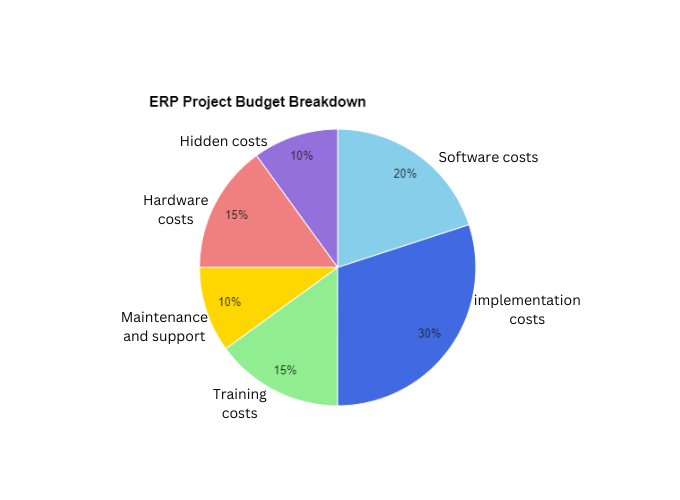11 Steps to Choosing ERP Software for Textiles
Let’s be honest, choosing ERP software for textiles that fits your unique business processes is tough. It is a lengthy process spanning several months and often the implemented ERP fails to deliver expected results.
So, how do you avoid this?
ERP is a business management system that enables you to manage and track Inventory Management, Production Planning and Control, Supply Chain Management, Sales and Order Management, Financial Management, Human Resources Management, Quality Management and much more.
While there are several generic ERP systems available in the market, having a textile focused ERP shortens your implementation time and can start delivering ERP ROI in a few weeks to 3 months’ time. Recent studies show that 95% of businesses improve their processes after implementing an ERP system.
This textile ERP software selection guide will help you make the right decisions while choosing the best ERP software for your textile business.
Choosing ERP Software for Textiles? Follow These 11 Steps
1) Assess your Business Needs
Assessing technological business needs allows you to target vendors that offer best ERP software for textile companies. These ERPs will directly address your business challenges as they come equipped with advanced and not just generic capabilities.

Carry out assessments such as:
- Mapping Current Processes which includes production, inventory management, procurement, finance, sales and customer service. This will help you understand the gaps in your current business processes.
- Engage Key Stakeholders from all key departments to gather their input on what they need from the ERP system. Engaging stakeholders will help you prioritize requirements and choose an ERP that fulfils all essential need.
- Evaluate Technical Requirements by reviewing your existing IT infrastructure to understand compatibility requirements. Ensure that the new ERP system can integrate seamlessly with your current systems and hardware.
2) Assemble a Selection Committee
After you know your business needs completely, the next step involves forming a team comprising of representatives from all key departments. This includes decision makers from production, finance, IT, sales, and human resources. This team will offer unique insights into their specific needs and challenges and ultimately help you in choosing ERP software for textiles.
Steps to assemble the team can include:
- Appoint a Dedicated Project Manager to lead the selection process. This individual should have strong project management skills and experience with ERP implementations.
- Define Roles and Responsibilities as to who will be the Decision Makers, Evaluators, Advisors, Stakeholder Communicators. Having roles clearly defined will increase your team’s productivity and simplify the decision-making process.
- Ensure IT support is part of the team. These can be IT representatives who can assess technical compatibility, integration capabilities, and infrastructure requirements.

3) Define your Budget
Once you have a team in place, budget should be the next thing that you plan. Defining a budget while choosing ERP software for textiles will ensure you allocate sufficient resources and increase potential cost savings to achieve a successful implementation. Studies highlight that 46% of businesses believe that cost savings are among the top three goals for implementing ERP. These steps involve:

- Determining Total Cost of Ownership (TCO) which involves Software, Implementation, Training, Maintenance, Support, and Hardware costs. These are usually the upfront expenses that indicate how much the ERP implementation will cost you.
- Consider Potential Hidden Costs such as Customization Fees, Integration Costs and Post-Implementation Support. These comprise the additional expenses that you have to pay to ensure your ERP meets your specific requirements.
- Getting Stakeholder Approval by preparing a detailed proposal outlining the budget, expected benefits, and justifications for the investment. This step will ensure all your stakeholders are onboard with the ERP implementation.
4) Research Potential Vendors
Researching ERP vendors will help you find the best ERP software for textile companies. This step is crucial as the quality of your vendor can make or break the project.
You can identify potential vendors by understanding their offerings and evaluating their suitability. Follow these steps:
- Compile a List of Potential Vendors with experience in the textile manufacturing industry. Industry-expertise will simplify your implementation process as the vendor will understand each of your business requirement fully.
- Use Official Websites of ERP Vendors as sources of information as they typically provide detailed information about their products, features, and industry solutions. Avoid relying on third-party sources as you might end up with incorrect information.
- Evaluate Key Criteria before choosing ERP software for textiles to determine vendor’s suitability. These include the ERP’s functionality, scalability, technology stack, cost, etc.
5) Develop a Request for Proposal (RFP)
Once you have prepared a list of potential ERP vendors, you need to communicate your requirements to them. This can be best accomplished by creating a detailed RFP. The RFP must clearly mention your expectations from the ERP which will help vendors to analyze if they can meet your requirements and submit proposals accordingly.

Making your first RFP can prove to be a challenging task and will need proper guidance. Here is a template of a general RFP document template to get u started. You can also follow the below approach within your RFP document:
- Outline Business and Technical Needs by clearly describing your business processes, challenges, and goals for the ERP system.
- Define Evaluation Criteria by establishing how proposals will be evaluated, focusing on functionality, usability, scalability, cost, vendor reputation, and support services.
- Request Vendor and Cost Information which should include their experience and success stories in the textile industry. Ask a detailed cost structure, covering all aspects like software, implementation, training, and maintenance, along with a total cost of ownership analysis.
- Clear Submission Instructions providing clear instructions on proposal submissions, including format, contact information and deadlines.
6) Evaluate Vendor’s Proposal
After you receive vendor proposals in response to your RFP, you have to follow a proper process to evaluate them. Adequate evaluation will help you ensure that you choose a solution that best meets your business needs and goals.
Here’s an approach to effectively evaluate vendor proposals:
- Establish Evaluation Criteria before making the decision. The best ERP software for textile companies should support your business requirements in terms of functionality, scalability, cost, vendor experience, technical requirements, user friendliness, support and training.
- Perform Cost-Benefit Analysis by considering initial costs, ongoing costs, and return on investments (ROI). This step will ensure that you are choosing a vendor that matches your budget allowance.
- Perform Risk Assessment by identifying implementation risks, evaluate vendor stability, seek clarifications if needed and conduct a final comparison with team input to make an informed decision.

7) Schedule Demos and Workshops
Your shortlisted vendors should be ready to schedule demos and workshops that will help you and your team gain hands-on experience with the software to make a good decision. Also, do research looking for free demos. This establishes the legitimacy of the vendors and their product.

Here are some points to keep in mind when scheduling them:
- Request Live Demonstrations of their ERP systems. Ensure these demos focus on your specific industry needs, especially in textile manufacturing.
- Organize Workshops where key stakeholders from your company can interact directly with the ERP vendor. Invite representatives from various departments such as production, inventory management, finance, and IT to participate.
- Ask for Clarifications if there are any doubts or uncertainties during demos or workshops. Look into features that are crucial for your business that might not have been covered adequately in the proposal.
8) Check References and Reviews
Before finalizing a vendor and choosing ERP software for textiles, checking references and reviews is crucial. It will help you gain insights into real-world experiences of other textile manufacturers with the vendor and their ERP system.
Here’s how to do it effectively:
- Contact References by reaching out to businesses or companies that have implemented the ERP systems you are considering. Ask specific questions about their experience with vendors and their ERP systems.
- Look for Online Reviews on reputed software review platforms or industry forums where businesses share their experiences with ERP vendors.
- Use Industry Networks and attend industry conferences or seminars where ERP vendors present their solutions. Not just that but you might also interact with other industry peers who can provide you with valuable recommendations or warnings based on their ERP experiences.

9) Assess Integration and Customization Capabilities
If you have been using other software applications to run your business and if you wish to retain them along with the ERP then assessing integration capabilities of the chosen ERP is vital. The level of integration and customization that the ERP can offer will ensure easy communication and data flow between the ERP system and other software/hardware your business relies on.

Here are some assessments to perform:
- Evaluate ERP System’s Flexibility to customize workflow processes without extensive coding. Check if it offers different modules that can be easily customized to meet your business needs.
- Ensure Vendor Offers Tools or Services for Integration. The vendor should be ready to offer support when it comes to integrating the ERP with other systems. This will make it easier for you to implement the ERP and ensure it fits your workflow seamlessly.
- Evaluate Ease of Implementation and Upgradability by how the vendor plans to execute the implementation process. Your chosen ERP should also be compatible enough to upgrade as per advancing technology.
10) Evaluate Vendor Support and Training
Both vendor support and training are essential if you want to ensure you get the most out of your textile ERP. Adequate training will ensure that your team can effectively use the system. On the other hand, robust vendor support will ensure that you receive assistance with the software whenever you face any issue.
Here are some things you need to check for:
- Check Support Availability and Quality by ensuring vendor offers 24/7 support with defined response times. Check their customer satisfaction rate, support team’s expertise, etc., and validate these through client references.
- Review Training Programs by assessing initial/ongoing training methods, including on-site sessions, webinars, and online courses. Make sure all the training programs provided by the vendor are interactive.
- Evaluate Long-Term Support and Additional Services by reviewing policies on system maintenance, updates, and upgrades. Ensure support services can scale with your business growth.

11) Make a Decision and Negotiate the Contract
The last step in choosing ERP software for textiles is to make a final decision on which software has met your business requirements among all shortlisted ones and negotiate with the respective vendor about details of contract.

This can prove to be a challenging task to execute so here are some key points to consider:
- Prepare for Negotiation by understanding your priorities and budget constraints. Research vendor’s negotiation flexibility and prepare justifications for your requests.
- Negotiate Contract Terms by keeping in mind the following points:
- Discuss pricing, payment terms, and total cost of ownership.
- Set clear implementation timelines with penalties or incentives.
- Define service level agreements (SLAs) for system support.
- Specify support, training programs, customization and integration requirements.
- Clarify warranties, liabilities and legal protection.
- Perform Legal Review by engaging legal experts to analyse the contract for compliance, protection of interests. Pay special attention to intellectual property, confidentiality, and dispute resolution clauses.
- Finalize and Sign only after ensuring all modifications and terms are reflected in the final contract in presence of selection committee.
Choosing ERP software for textiles is a complex and challenging task. The process will need assistance of a roadmap. This blog acts as a standard textile ERP software selection guide to your journey of selecting the right ERP system. By following these 11 steps, you can systematically assess your needs, engage stakeholders, set a realistic budget, and thoroughly evaluate potential vendors. It will lead you to evaluate all details and qualifications of selected vendors. Finally, it will assist you to make the best decision and providing proper negotiations strategies while finalizing the contract.

